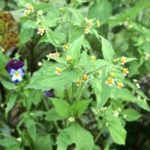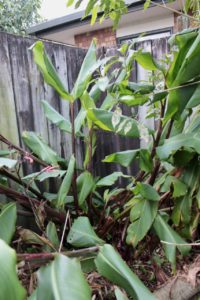
Arrowroot stems
I recently discovered a valuable plant in the garden I didn’t know I had. It’s Queensland arrowroot Canna edulis but it actually comes from South American and in Peru it is known as Achira where it was domesticated 5000 years ago.
I acquired the plant at a crop swap some years ago and we was told it was tapioca. I planted it in the back corner of the garden and forgot about it. I did notice it sent up very tall stems 2-3m tall with big banana like leaves over time and this year one stem had a bright red flower which looked like canna flowers. The plants have formed a dense patch of rhizomes.
Canna edulis is not tapioca which is a starch extracted from roots (quite different to those
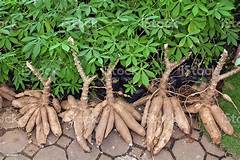
Tapioca plant and rhizomes
on my plants) of the cassava plant Manihot esculenta also known as manioc. It gets more interesting because the term Arrowroot is the name used for starch obtained from rhizomes of several tropical plants, traditionally Maranta arundinacea, Florida arrowroot Zamia integrifolia, and cassava often labelled as arrowroot. Polynesian arrowroot or pia Tacca leontopetaloides, and Japanese arrowroot Pueraria lobate also called kudzu are used in similar ways. Kudzu is a very invasive ‘weed’ in the US, a smothering plant which we also have in NZ and there are four sites controlled by the Council in the BOP.

Red flowering canna indica lily
The common Canna Canna indica is also edible but the rhizomes are very thin, nor does it
get as tall and it more of a spreader. However, it is grown for the many different coloured prolific flowers.
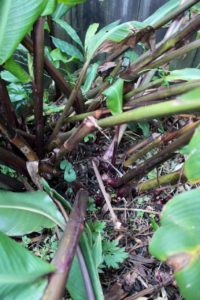 Morag Gamble in Queensland shares on Youtube the many virtues of Arrowroot. It’s her favourite plant in her permaculture garden. She cuts and drops it for mulch as well as fodder for sheep, pigs and chickens. Once the chickens have broken down the leaves and mixed in their droppings it’s put on raised beds. It can be planted for shelter
Morag Gamble in Queensland shares on Youtube the many virtues of Arrowroot. It’s her favourite plant in her permaculture garden. She cuts and drops it for mulch as well as fodder for sheep, pigs and chickens. Once the chickens have broken down the leaves and mixed in their droppings it’s put on raised beds. It can be planted for shelter
from wind and for shade and is fast growing, but is frost tender and dies down in winter. My tall stems have all fallen over and I’ll cut them up for mulch. It is easy to propagate by separating a stem or rhizome off the main plant. My plants have made such a dense patch of rhizomes they’re hard to dig out.
How to use the rhizomes? Detach a rhizome from the base of the stem. They don’t keep well off the plant so one harvest as you need. The scales on the outside need to be peeled off and then young rhizomes are cut up and boiled which brings out their mucilaginous quality. The taste is between a parsnip and an artichoke. They also contain fibrous strings. To obtain the arrowroot the root is rasped to a pulp, then washed and strained to get rid of
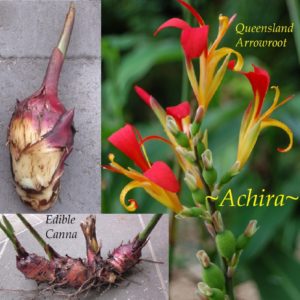
Canna edulis or Achira
the fibres. The resulting starch is very digestible as large grains easily seen with the naked eye, about three times the size of potato starch grains. The roots contain about 25% starch. The starch is high in potassium, low in calcium and phosphorus. I have been buying arrowroot powder as a gluten free thickener, I’ll try making my own. The young leaves can also be eaten as a green vegetable and contain at least 10% protein. Finally the immature seeds can be cooked in tortillas.
I am thrilled I have this plant of many uses!
